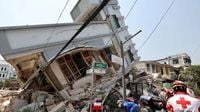An earthquake of magnitude 5.8 on the Richter scale struck Afghanistan on Saturday, April 19, 2025, at 12:17 PM IST, according to the National Center for Seismology (NCS). The tremors were felt across several regions, including parts of Jammu and Kashmir and the Delhi-NCR area, causing panic among residents.
The epicenter of the earthquake was located near the Afghanistan-Tajikistan border, at a depth of approximately 130 kilometers. Reports indicated that the tremors were also experienced in North-West Pakistan, including cities like Islamabad and Lahore.
Residents in Jammu and Kashmir reported feeling the quake quite strongly. A local from Srinagar recounted, "I felt the tremor. I was in the office when my chair shook," highlighting the suddenness and intensity of the event. Similarly, another resident expressed their experience on social media, stating, "A strong earthquake just struck Kashmir — it was sudden and intense. It really shook us. Hoping everyone is safe." Such reactions are common during seismic events, where the unexpected nature of earthquakes often leads to heightened anxiety.
This earthquake comes just days after another quake of magnitude 5 was recorded in Afghanistan on April 16, 2025, at 4:43 AM IST. This earlier tremor also affected the same regions, demonstrating the ongoing seismic activity in the area. The NCS reported that Afghanistan's geographical location on active fault lines makes it particularly vulnerable to seismic events, with the Indian and Eurasian tectonic plates colliding in this region.
In addition to the significant quake in Afghanistan, earlier on the same day, a smaller earthquake of magnitude 2.9 struck Nagaon district in Assam at 7:38 AM IST, occurring at a depth of 130 kilometers. The tremor in Assam, while minor compared to the one in Afghanistan, adds to the day's seismic activity in the region.
The United Nations Office for the Coordination of Humanitarian Affairs (UNOCHA) has noted that Afghanistan is particularly susceptible to natural disasters, including seasonal flooding and landslides, in addition to earthquakes. The country’s history of seismic activity and its geographical conditions pose ongoing challenges for its residents, many of whom are already facing the repercussions of decades of conflict and underdevelopment.
Earthquakes in Afghanistan are not uncommon, especially in the Hindu Kush region, which is known for its geological instability. The Red Cross has highlighted that this area experiences quakes annually, with varying magnitudes, contributing to the vulnerability of local communities.
In Pakistan, the recent tremors have stirred memories of past devastating earthquakes, such as the one in 2005 that resulted in over 74,000 fatalities. The frequency of seismic events in this region has led to a heightened awareness and preparedness among residents, although the psychological impact of such occurrences can still be significant.
As emergency services and local authorities assess the situation following the latest tremors, there have been no immediate reports of casualties or significant damage in the affected areas. However, the potential for aftershocks remains a concern, and residents are urged to stay vigilant and prepared.
In conclusion, the earthquake that struck Afghanistan on April 19, 2025, serves as a stark reminder of the region's geological volatility. With tremors felt across borders, the event underscores the interconnectedness of seismic activity in South Asia and the ongoing need for disaster preparedness and response strategies in vulnerable communities.






